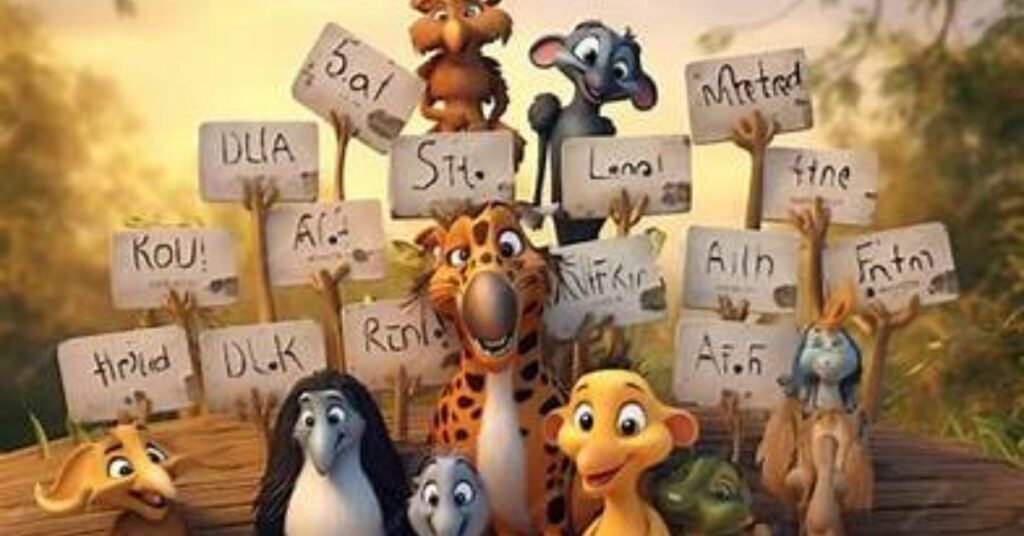Have you ever come across words that sound the same but have completely different meanings? These words are called homophone, and they can be a lot of fun, especially when related to animals. Homophones can create playful confusion, clever wordplay, and some laughter. In this article, we’ll explore some fascinating animal homophones that are sure to delight both language enthusiasts and animal lovers alike. Let’s dive into the world of sound-alike words and discover how they bring a fresh twist to everyday language.
What Are Homophones?
Before we jump into specific animal homophones, let’s clarify what a homophone is. Homophones are words that are pronounced the same but have different meanings and often different spellings. For example, “bear” (the animal) and “bare” (without covering) sound identical but have completely different definitions. These sound-alike words often trip people up, leading to amusing mix-ups in speech and writing. When animals get involved, the results can be even more entertaining.
Popular Animal Homophone
Homophone related to animals often appear in casual conversation, but they can also pop up in literature and jokes. Below are some of the most common animal homophone and their meanings.
Bear vs. Bare
The word “bear” can refer to a large, furry animal found in forests and mountains. However, when you remove the fur from the equation, you get “bare,” which means uncovered or exposed. These two words can create funny misunderstandings. Imagine telling someone to “bare with me” instead of “bear with me” – suddenly, you’ve unintentionally asked them to strip down instead of being patient!
Hare vs. Hair
A “hare” is a fast, long-eared animal resembling a rabbit, while “hair” refers to the strands that grow on a human’s head. The mix-up here is often playful, especially in tongue twisters or jokes. One famous example is the classic tale of “The Tortoise and the Hare,” where replacing “hare” with “hair” changes the story entirely!
Fowl vs. Foul
“Fowl” refers to birds, especially domesticated ones like chickens or ducks. On the other hand, “foul” means something unpleasant or offensive. These homophones frequently appear in expressions like “foul play,” where using “fowl play” as a pun can add a humorous twist to otherwise serious scenarios.
Mare vs. Mayor
A “mare” is a female horse, while “mayor” refers to the head of a town or city. Though the two words seem unrelated, mixing them up can lead to hilarious mental images. Imagine a conversation about a town’s leader where someone confuses “mayor” with “mare”—suddenly, the town is being governed by a horse!
Bass vs. Bass
Interestingly, “bass” is one of those words with two meanings pronounced differently depending on the context. When referring to a fish, it’s pronounced “base,” but when talking about low-frequency sounds or instruments, it’s pronounced “bass” (rhyming with “mass”). Despite this slight difference in pronunciation, they can cause confusion when spoken quickly, particularly in a conversation about both music and fishing!
Lesser-Known Animal Homophones
While some animal homophones are widely recognized, others are less commonly discussed but equally amusing. Let’s take a look at some of these lesser-known sound-alike words.
Pika vs. Pica
“Pika” refers to a small mammal found in colder climates, often mistaken for a rodent but closer to a rabbit. “Pica,” on the other hand, is a condition where a person craves non-food items like dirt or paper. These homophones may not appear in everyday conversation, but they can certainly spark curiosity when used together, especially in quirky discussions about animals or health conditions.
Seal vs. Seal
Just like “bass,” “seal” serves double duty as both an animal and a verb. A “seal” is a marine mammal known for its sleek body and playful nature, but to “seal” something means to close it tightly. The homophone here is easy to spot, and it often features in wordplay, especially in cartoons or children’s books, where seals might be used to seal envelopes!
Gnu vs. New
A “gnu” is a large African antelope, pronounced similarly to “new.” While gnu is a bit more obscure, it can still lead to fun puns. Imagine someone saying they have a “new gnu” – it sounds like they just received a fresh version of a mysterious object, but in reality, they’re talking about an antelope!
Auk vs. Orc
An “auk” is a type of seabird, while “orc” refers to a mythical creature often found in fantasy literature. Although these two words rarely come up in daily conversation, they present amusing opportunities for wordplay, particularly in fantasy novels or video games. It’s not every day you mistake a bird for a menacing creature, but the homophone allows for that comedic slip-up.
Why Are Animal Homophones So Fun?
Animal homophone offer a unique layer of fun and curiosity for language lovers. The playful confusion between these words can lead to humor, and in some cases, accidental puns. These word pairings also highlight how complex and rich the English language can be. While homophones exist in many languages, English boasts an impressive array of them, and animal-related ones are particularly enjoyable.
The fascination with homophones comes from their ability to create vivid mental images. When someone says “bare” instead of “bear,” your mind may conjure up a picture of a naked animal in the wild. These mental images stick with us, making homophones not only a linguistic challenge but also a source of entertainment.
How Homophones Enhance Language Play
Homophones can also be used in creative writing, particularly in poetry, puns, and humor. Writers often rely on homophones to create double meanings or surprising twists in their work. For example, the simple line, “The bear couldn’t bear it anymore,” uses both meanings of “bear” to convey an amusing, yet impactful message.
Additionally, homophones encourage us to think more carefully about language. They serve as a reminder that pronunciation isn’t always tied to meaning, and context is key. This is especially true for non-native speakers of English, who may find homophones challenging but rewarding to master.
How to Spot Homophones in Daily Life
Once you start looking for homophone, you’ll find them popping up everywhere. From advertisements to conversations, these sound-alike words are an integral part of our daily language. Try keeping a notebook or list of homophones you encounter, especially animal-related ones, and challenge yourself to use them creatively.
Whether you’re crafting a joke, writing a story, or just having fun with friends, animal homophones offer endless opportunities for creativity. The next time you hear someone say “I saw a hare,” don’t forget to ask if they meant the animal or a strand of hair!
Conclusion
Animal homophone may seem like a small part of the language, but they offer a unique way to play with words, create humor, and engage in thoughtful conversation. From the common bear/bare mix-up to the lesser-known pika/pica confusion, these words allow us to explore the richness of the English language in a fun and lighthearted way. So, next time you’re looking for a way to spice up your language, consider using some of these animal homophones for a playful twist!







